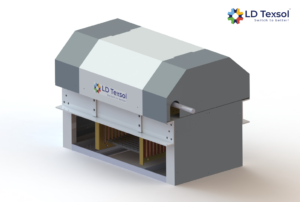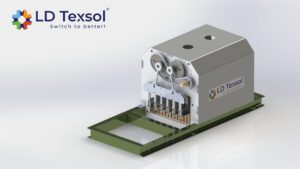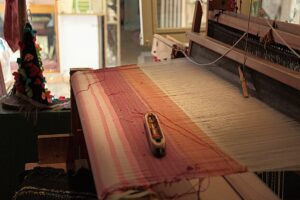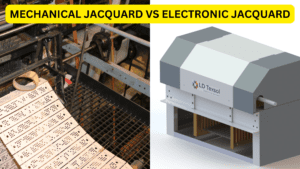Unraveling the Diversity of Textile Weaving Machinery
1. Power Looms:
Power looms represent the epitome of automation in textile weaving. These machines harness various power sources, such as electricity, to weave fabrics with unparalleled precision and speed. Industry pioneers have seamlessly integrated advanced electronic jacquard loom into their manufacturing processes, significantly enhancing operational efficiency and output.
2. Air Jet Looms:
Renowned for their exceptional speed and versatility, air jet looms have become a staple in the textile industry. These looms utilize compressed air to propel the weft yarn through the shed, ensuring not only speed but also maintaining a high standard of quality and productivity.
3. Water Jet Looms:
Embracing water as a propellant, water jet looms offer a diverse range of weaving possibilities. Companies committed to sustainability have optimized these looms for efficiency, minimizing their environmental footprint while ensuring superior fabric quality.
4. Projectile Looms:
Projectile looms employ a small metal piece, aptly named a projectile, to insert the weft yarn. This method, a testament to the industry’s dedication to diverse weaving techniques, allows for the creation of unique fabric structures.
5. Electronic Jacquard Loom:
At the forefront of weaving technology, electronic jacquard loom represent a paradigm shift. These looms leverage digital control systems to independently lift individual warp threads, offering an unprecedented level of intricacy in patterns and designs. Industry leaders have seamlessly integrated electronic jacquard loom into their Innovative Looms, providing a new dimension of flexibility and creativity in fabric production.

Technological Advancements at the Core
1. Powerful Integration of Technology:
The heart of success in the textile industry beats in tandem with technological advancements. Industry players continually invest in state-of-the-art weaving machinery, with a particular focus on integrating cutting-edge technologies like electronic jacquard systems into their Weaving Machinery Integration looms. This commitment solidifies their position as leaders in the dynamic textile landscape.
2. Customization for Excellence:
Recognizing the diverse needs of the market, companies prioritize customization in their weaving machinery, Versatile Looms, and Electronic Jacquard Customization. This emphasis extends to electronic jacquard loom, ensuring the production of a broad spectrum of fabrics. From traditional textiles to avant-garde materials, the flexibility of these machines allows companies to meet the demands of an ever-evolving market.
3. Sustainable Weaving Practices:
In an era where sustainability is not just a buzzword but a fundamental responsibility, companies transcend industry standards. This commitment extends to weaving processes, including those utilizing electronic jacquard technology. Weaving machinery is optimized for energy efficiency, Sustainable Weaving, Eco-Friendly Looms, Environmental Impact Reduction, Green Weaving Practices, and environmentally conscious practices are embraced to reduce the overall environmental impact of textile production.
Navigating the Threads: Textile Yarns Explored
The synergy between weaving machinery and textile yarns is a critical factor in producing high-quality fabrics. Let’s explore the various types of yarns that contribute to the intricacies of the weaving process.
1. Cotton Yarns:
Renowned for its breathability and comfort, cotton yarns are a staple in the textile industry. Industry leaders select premium cotton yarns, ensuring the creation of soft and durable end products that resonate with consumer preferences.
2. Synthetic Yarns:
In a world driven by innovation, synthetic yarns play a pivotal role. The industry catalog boasts a spectrum of synthetic yarns, each engineered for specific applications. From high-performance sportswear to industrial materials, synthetic yarns offer versatility and durability.
3. Blended Yarns:
Industry innovators excel in the art of blending yarns, creating unique combinations that harness the strengths of both natural and synthetic fibers. This versatility extends the possibilities for textile applications, catering to a diverse market with a myriad of fabric options, Blended Yarns, Textile Combinations, and Natural and Synthetic Fiber Blending.
Weaving Tomorrow’s Textiles Today
As the textile industry continues its evolutionary journey, companies pioneering in weaving machinery and yarn production remain beacons of excellence. In this comprehensive guide, we’ve unraveled the intricacies of textile weaving machinery, explored industry contributions, and navigated the diverse landscape of textile yarns. As we continue to weave the fabric of tomorrow, leaders in the industry seamlessly blend tradition with technology, crafting a narrative of innovation, Innovation in Weaving, Quality Textile Production, Sustainable Fabric Creation, quality, and sustainability.
Discover the art and science behind textile weaving machinery, where every thread tells a story of innovation and quality. The convergence of traditional craftsmanship with cutting-edge technology ensures that the textiles of tomorrow are not just woven but crafted with precision, care, and an eye toward a sustainable future.






Real fantastic info can be found on blog.